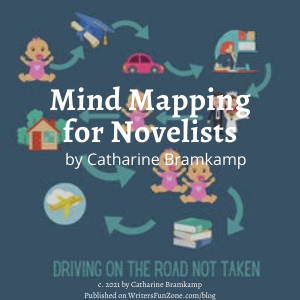Mind Mapping for Novelists: Driving on the Road Not Taken by Catharine Bramkamp
 Let’s welcome back monthly columnist Catharine Bramkamp as she shares with us “Mind Mapping for Novelists: Driving on the Road Not Taken.” Enjoy!
Let’s welcome back monthly columnist Catharine Bramkamp as she shares with us “Mind Mapping for Novelists: Driving on the Road Not Taken.” Enjoy!
***
A strong technique for discovering more about your fictional characters as well as your own life is mind mapping.
Mind mapping is journaling with images, circles, lines, whatever you’d like. The goal is to create a unique map illustrating where you’ve been and better — where you want to go.
For example, like in the illustration, maybe you’ve followed a wide highway that is easy, familiar, and built for speed.
Everyone knows where you are going. YOU know where you are going. Nothing wrong with that, especially since upon graduation we are often presented a clearly marked map.
(I skip over most education paths since those are well worn and institutionalized. University maps look like illuminated manuscripts and are just as revered.)
But what if you wanted to slow down?
What is Your Road Not Taken?
Check out a detour, take an off ramp.
What will you find – paradise or burning flames?
You don’t know but your brain does.
Your brain evolved to never ask questions and to always stay safe: drive the speed limit, keep your eyes on the road. So you do. Except you don’t want to. Or your character doesn’t want to.
Did you long to take an unmarked path but lacked the machete or plow or shovel to make it passable?
What a mind map can show you is not just your past but patterns that can help you literally map out a different future. It is a visualization tool that allows you to see tantalizing but narrow detours.
What if you took them? It’s not like you don’t know where the highway is located; you can return.
How delicious to explore. Fill the tank, take the exit.
Your Road Not Taken: Your Mind Map
As you consider your mind map, back-fill the interests and the inspirations that did not happen.
What did you pass by?
- On the way to the wedding did you speed by the sign pointing to travel?
- On the path to a secure job did you bypass five signs for painting or theater?
- Did you miss the maternity off ramp?
- Did you turn left, towards the promotion but away from the music gig?
Once that idea appears, sketch it into the mind map.
This is not to depress you, but to show you possibilities that may still be available for reconsideration.
- Did you always want to travel?
- Did you miss a chance to graduate in a field you still find fascinating?
To explore those paths missed, or were simply impractical (bad road conditions, unclear signage, no rest stops), journal about them.
Write about where you were headed, and why you did or did not drive down that particular road.
Find new directions.
I discovered a brand new map while thumbing through a book by Eric Maisel. In it he mentioned creativity coaching. You can do that?
Just that one sentence gave me permission to draw out a route that led to working with clients as a writing coach, from there starting up Writing From the Queen’s Seat.
This new direction is very different than the clear, debris free road of non-profit work I had been currently traveling. And I’m not sorry.
Or maybe you do own an interesting map but can’t turn the car off the current route.
Journal about The Road Not Taken
Journal about taking that road. Maybe today you own a truck and can rush down a rocky road that was completely impossible driving a minivan with two child seats.
Maybe you need to write a whole book about the road not taken, or share your adventure, that now you see on a map, was pretty great.
As writers we can share our detours with readers so they can experience what they may have missed, or we can hand them a new map.
A map is a living document.
I am continually filling in my map with remembered paths and routes as well as sketches of the roads not taken.
What Would Have Happened?
Sometimes I journal about them, wondering what would have happened. And those wonderings and ideas often serve to fuel and record the regrets and longings of my fictional characters.
If I wanted to always work in fashion, but took a road that led to a different school with a different but equally fascinating major, perhaps I can explore what I missed in my next novel.
Fictional characters benefit from their own mind-maps.
These simple maps help create complex characters complete with history, aspirations, and genuine regret for their own roads not taken.
And to circle back, my heroine’s road not taken looks a lot like mine.
***
Want to read more articles like this one Writer’s Fun Zone? Subscribe here.
***
ABOUT THE AUTHOR
 Catharine Bramkamp is a successful writing coach, Chief Storytelling Officer, former co-producer of Newbie Writers Podcast, and author of a dozen books including the Real Estate Diva Mysteries series, and The Future Girls series. She holds two degrees in English and is an adjunct university professor. After fracturing her wrist, she has figured out there is very little she is able to do with one hand tied behind her back.
Catharine Bramkamp is a successful writing coach, Chief Storytelling Officer, former co-producer of Newbie Writers Podcast, and author of a dozen books including the Real Estate Diva Mysteries series, and The Future Girls series. She holds two degrees in English and is an adjunct university professor. After fracturing her wrist, she has figured out there is very little she is able to do with one hand tied behind her back.






